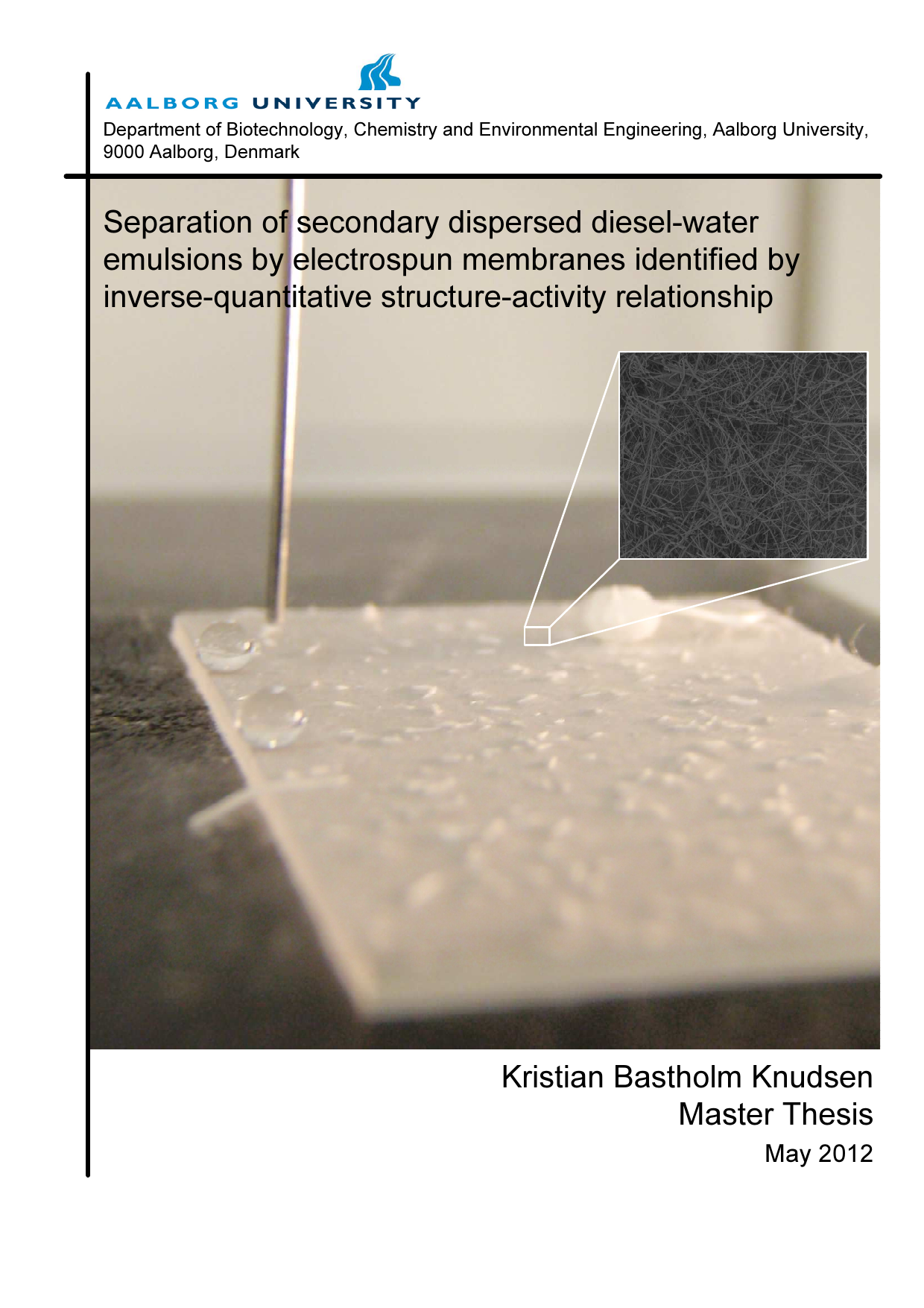
Separation of secondary dispersed diesel-water emulsions by electrospun membranes identified by inverse-quantitative structure-activity relationship
Translated title
Separation af sekundære diesel-vand emulsioner med electrospundet membraner identificeret ved brug af inverse-quantitative structure-activity relationship
Author
Term
4. term
Education
Publication year
2012
Submitted on
2012-06-15
Pages
75
Abstract
Dette projekt har fokuseret på fremstillingen af nye membraner til separationen af sekundære dispersioner af vand-i-diesel. Interessen for at øge effektivitet og mindske tryktabet er i takt med anvendelsen af biodiesel steget, hvilket skyldes, at biodiesel indeholder en række surfak- tanter, som mindsker vand dråbe distributionen i diesel samt øger indholdet af bundet vand. Dette mindsker brændstof økonomien samt levetiden på motorer og ønskes derfor fjernet. Separationen af sekundære dispersioner af vand-i-diesel har tidligere vist, at være afhængig af membranen overfaldens hydrophobicitet. Hydrofobiciteten er en funktion af både overflade en- ergi samt struktur og i søgen efter nye membran materialer blev en inverse-quantitative structure- activity relationship model, baseret på den kritiske overflade energi af polymere, udviklet. Modellen forudsagde nye potentielle polymer strukturer med lav kritisk overflade energi, dvs. hydrofobe polymere. Løsningerne blev subjektivt evalueret og resulterede i købet af poly(styrene- co-a-methylstyrene), PSMS. Overfladen af PSMS blev eksperimentelt undersøgt og resulterede i en vand kontakt vinkel på 94.10±3.73o, som derved kunne karakterers, som værende hydrofobt. For at øge hydrofobiciteten ydereligere blev PSMS electrospundet, hvilket er en proces, som vha. elektrostatiske kræfter danner fibre. Dannelsen af fibre inducere ujævnheder og huller i overflade strukturen og kan derved øge hydrofobiciteten. Dette var tydeligt, da electrospindin- gen af PSMS producerede overflader med vand kontakt vinkler på 165.85±0.51o, hvilket kan karakteriseres som værende en superhydrofob overflade. Membraner blev på baggrund af ovenstående forsøg fremstillet ved at electrospinde PSMS på et support materiale. Membraner, som blev electrospundet udfra 60 w/w % PSMS/DMF og med en aflejringsmasse på 30 g PSMS/m2, opnåede den maksimale fjernelsesprocent på 93.85±2.65 % med et tryktab over membranen på 0.64±0.17 kPa.
This present project has focused on the fabrication of novel membranes for the separation of secondary dispersions of water-in-diesel. The quest of improving the efficiency and reduce the pressure drop of such filtrations has, due to the introduction of biodiesel, increased caused by the content of surfactants in biodiesel. The surfactants decrease the drop size distribution and increase the concentration of total water, which decreases the combustion efficiency and lifetime of engines. The separation of secondary dispersions of water-in-diesel has previously been demonstrated to be dependent on the hydrophobicity of the membrane surface. The hydrophobicity of a surface is both dependent on the surface energy and surface morphology. In the search of a novel mem- brane material an inverse-quantitative structure-activity relationship was developed on the basis of polymers’ critical surface tensions. The model predicted new potential polymers with low critical surface tensions, i.e. hydro- phobic materials. The solutions were then subjective evaluated, which resulted in the purchase of poly(styrene-co-a-methylstyrene), PSMS. The surface of PSMS was experimentally characterized by measuring the water contact angle, which resulted a contact angle of 94.10±3.73o, thus PSMS could be characterized as being hydrophobic. To further increase the hydrophobicity, PSMS was electrospun. This is a process that utilize electrostatic forces to form polymeric fibers with induced pores and hollows, thus increasing the hydrophobicity of the surface. The electrospinning of PSMS resulted in surfaces with a water contact angle of 165.85±0.51o hereby producing superhydrophobic surfaces. Membranes were, on the basis of the previous results, fabricated by electrospinning PSMS on a support material. Membranes, that were electrospun using a 60 w/w % PSMS/DMF solution and a deposited mass of 30 g PSMS/m2, achieved the highest separations efficiencies of 93.85±2.65 % with a pressure drop of 0.64±0.17 kPa.
Keywords
Documents
